Questions and Answers on Health Assessment and Nursing Care
VerifiedAdded on 2023/06/11
|21
|3668
|374
AI Summary
This article provides answers to various questions related to health assessment and nursing care, including identifying determinants of health, involving patients and their families in decision making, documenting patient information, and more.
Contribute Materials
Your contribution can guide someone’s learning journey. Share your
documents today.

Running head: QUESTIONS AND ANSWERS
QUESTIONS AND ANSWERS
Name of the student:
Name of the university:
Author note:
QUESTIONS AND ANSWERS
Name of the student:
Name of the university:
Author note:
Secure Best Marks with AI Grader
Need help grading? Try our AI Grader for instant feedback on your assignments.
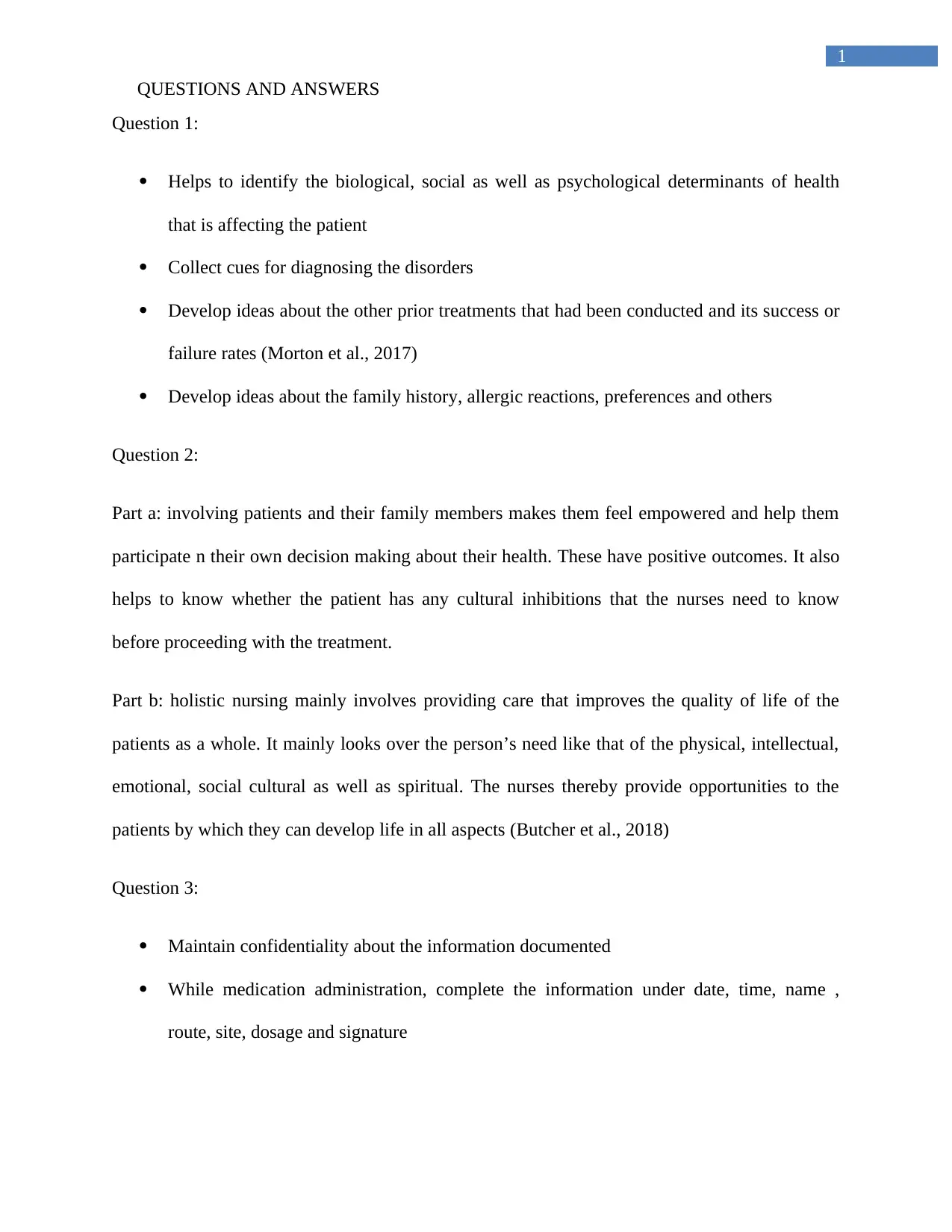
1
QUESTIONS AND ANSWERS
Question 1:
Helps to identify the biological, social as well as psychological determinants of health
that is affecting the patient
Collect cues for diagnosing the disorders
Develop ideas about the other prior treatments that had been conducted and its success or
failure rates (Morton et al., 2017)
Develop ideas about the family history, allergic reactions, preferences and others
Question 2:
Part a: involving patients and their family members makes them feel empowered and help them
participate n their own decision making about their health. These have positive outcomes. It also
helps to know whether the patient has any cultural inhibitions that the nurses need to know
before proceeding with the treatment.
Part b: holistic nursing mainly involves providing care that improves the quality of life of the
patients as a whole. It mainly looks over the person’s need like that of the physical, intellectual,
emotional, social cultural as well as spiritual. The nurses thereby provide opportunities to the
patients by which they can develop life in all aspects (Butcher et al., 2018)
Question 3:
Maintain confidentiality about the information documented
While medication administration, complete the information under date, time, name ,
route, site, dosage and signature
QUESTIONS AND ANSWERS
Question 1:
Helps to identify the biological, social as well as psychological determinants of health
that is affecting the patient
Collect cues for diagnosing the disorders
Develop ideas about the other prior treatments that had been conducted and its success or
failure rates (Morton et al., 2017)
Develop ideas about the family history, allergic reactions, preferences and others
Question 2:
Part a: involving patients and their family members makes them feel empowered and help them
participate n their own decision making about their health. These have positive outcomes. It also
helps to know whether the patient has any cultural inhibitions that the nurses need to know
before proceeding with the treatment.
Part b: holistic nursing mainly involves providing care that improves the quality of life of the
patients as a whole. It mainly looks over the person’s need like that of the physical, intellectual,
emotional, social cultural as well as spiritual. The nurses thereby provide opportunities to the
patients by which they can develop life in all aspects (Butcher et al., 2018)
Question 3:
Maintain confidentiality about the information documented
While medication administration, complete the information under date, time, name ,
route, site, dosage and signature
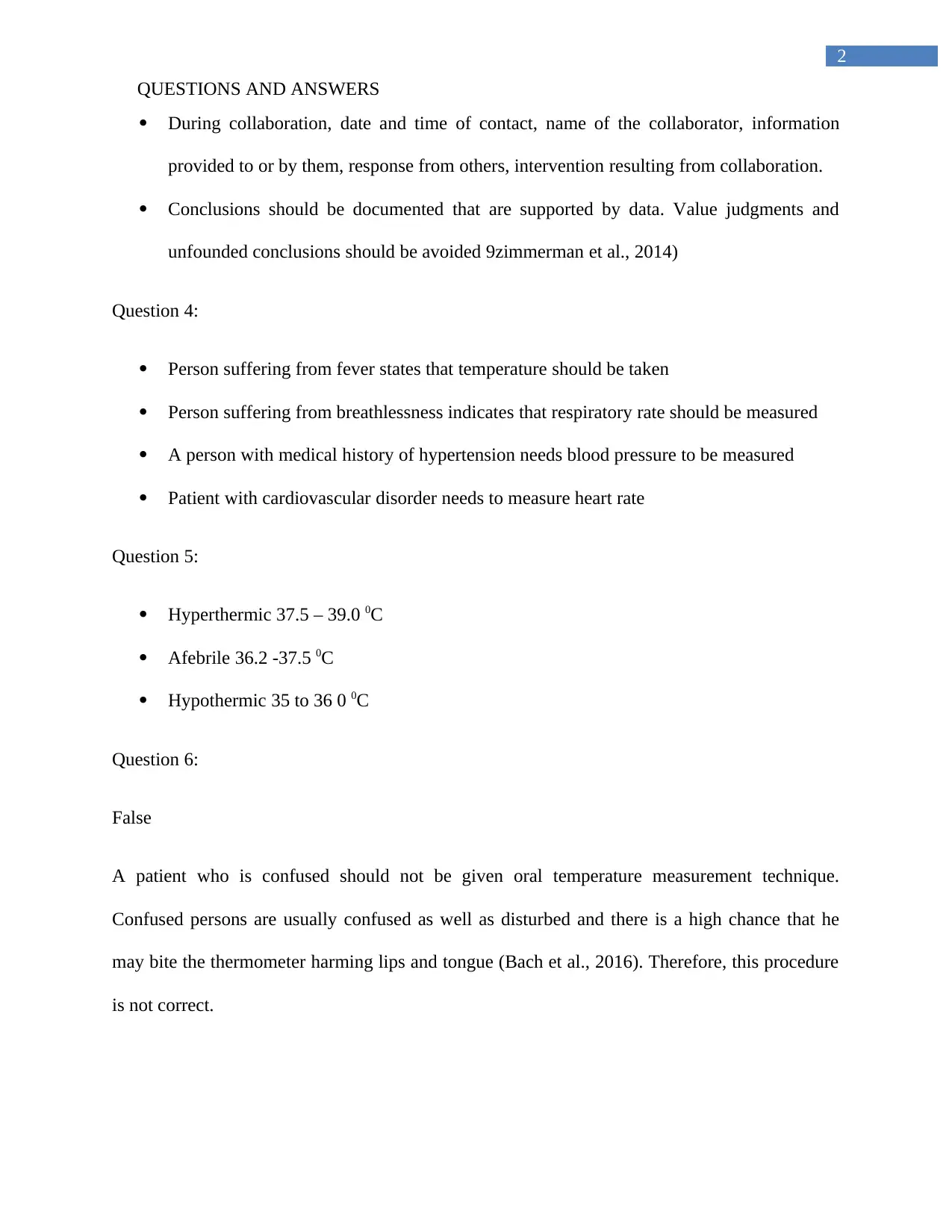
2
QUESTIONS AND ANSWERS
During collaboration, date and time of contact, name of the collaborator, information
provided to or by them, response from others, intervention resulting from collaboration.
Conclusions should be documented that are supported by data. Value judgments and
unfounded conclusions should be avoided 9zimmerman et al., 2014)
Question 4:
Person suffering from fever states that temperature should be taken
Person suffering from breathlessness indicates that respiratory rate should be measured
A person with medical history of hypertension needs blood pressure to be measured
Patient with cardiovascular disorder needs to measure heart rate
Question 5:
Hyperthermic 37.5 – 39.0 0C
Afebrile 36.2 -37.5 0C
Hypothermic 35 to 36 0 0C
Question 6:
False
A patient who is confused should not be given oral temperature measurement technique.
Confused persons are usually confused as well as disturbed and there is a high chance that he
may bite the thermometer harming lips and tongue (Bach et al., 2016). Therefore, this procedure
is not correct.
QUESTIONS AND ANSWERS
During collaboration, date and time of contact, name of the collaborator, information
provided to or by them, response from others, intervention resulting from collaboration.
Conclusions should be documented that are supported by data. Value judgments and
unfounded conclusions should be avoided 9zimmerman et al., 2014)
Question 4:
Person suffering from fever states that temperature should be taken
Person suffering from breathlessness indicates that respiratory rate should be measured
A person with medical history of hypertension needs blood pressure to be measured
Patient with cardiovascular disorder needs to measure heart rate
Question 5:
Hyperthermic 37.5 – 39.0 0C
Afebrile 36.2 -37.5 0C
Hypothermic 35 to 36 0 0C
Question 6:
False
A patient who is confused should not be given oral temperature measurement technique.
Confused persons are usually confused as well as disturbed and there is a high chance that he
may bite the thermometer harming lips and tongue (Bach et al., 2016). Therefore, this procedure
is not correct.
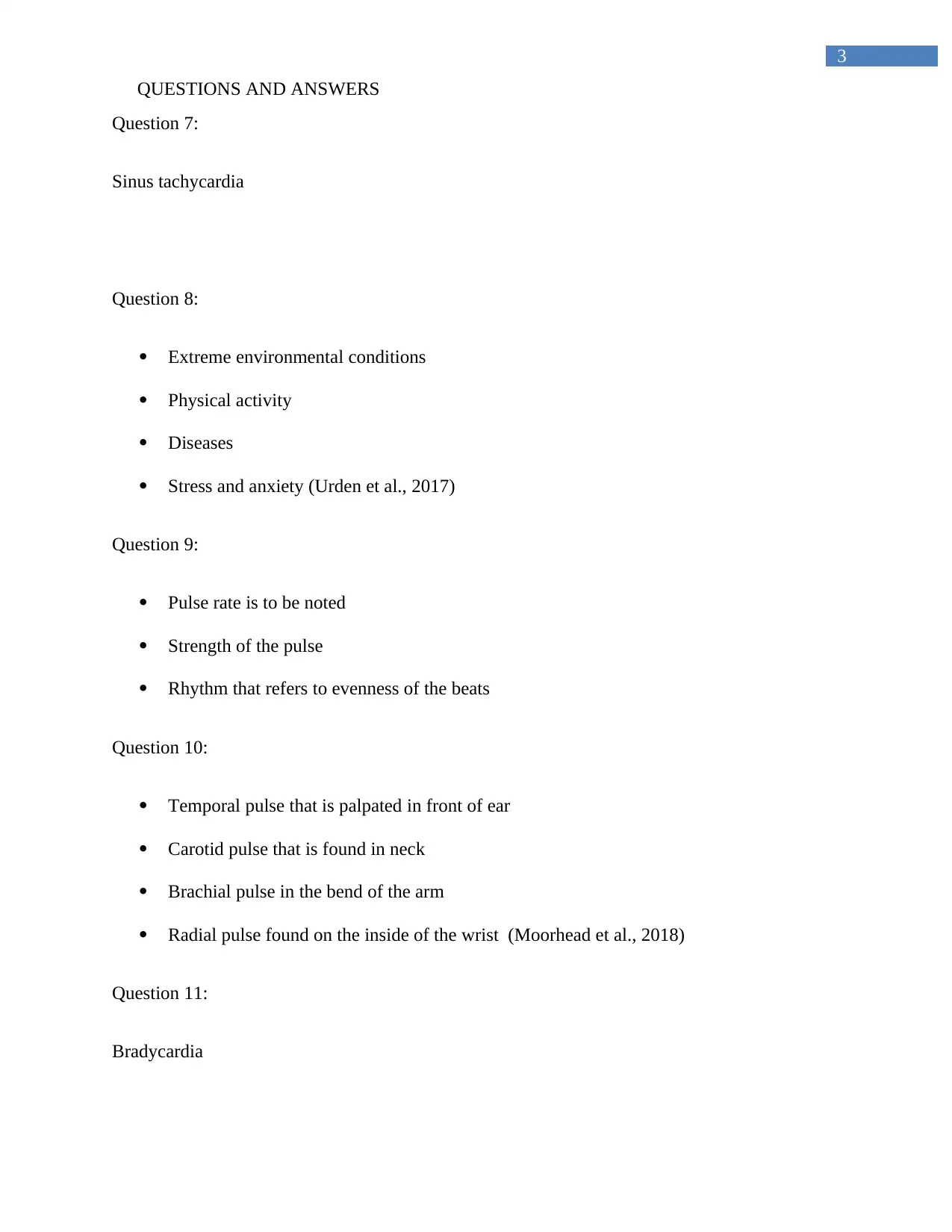
3
QUESTIONS AND ANSWERS
Question 7:
Sinus tachycardia
Question 8:
Extreme environmental conditions
Physical activity
Diseases
Stress and anxiety (Urden et al., 2017)
Question 9:
Pulse rate is to be noted
Strength of the pulse
Rhythm that refers to evenness of the beats
Question 10:
Temporal pulse that is palpated in front of ear
Carotid pulse that is found in neck
Brachial pulse in the bend of the arm
Radial pulse found on the inside of the wrist (Moorhead et al., 2018)
Question 11:
Bradycardia
QUESTIONS AND ANSWERS
Question 7:
Sinus tachycardia
Question 8:
Extreme environmental conditions
Physical activity
Diseases
Stress and anxiety (Urden et al., 2017)
Question 9:
Pulse rate is to be noted
Strength of the pulse
Rhythm that refers to evenness of the beats
Question 10:
Temporal pulse that is palpated in front of ear
Carotid pulse that is found in neck
Brachial pulse in the bend of the arm
Radial pulse found on the inside of the wrist (Moorhead et al., 2018)
Question 11:
Bradycardia
Secure Best Marks with AI Grader
Need help grading? Try our AI Grader for instant feedback on your assignments.
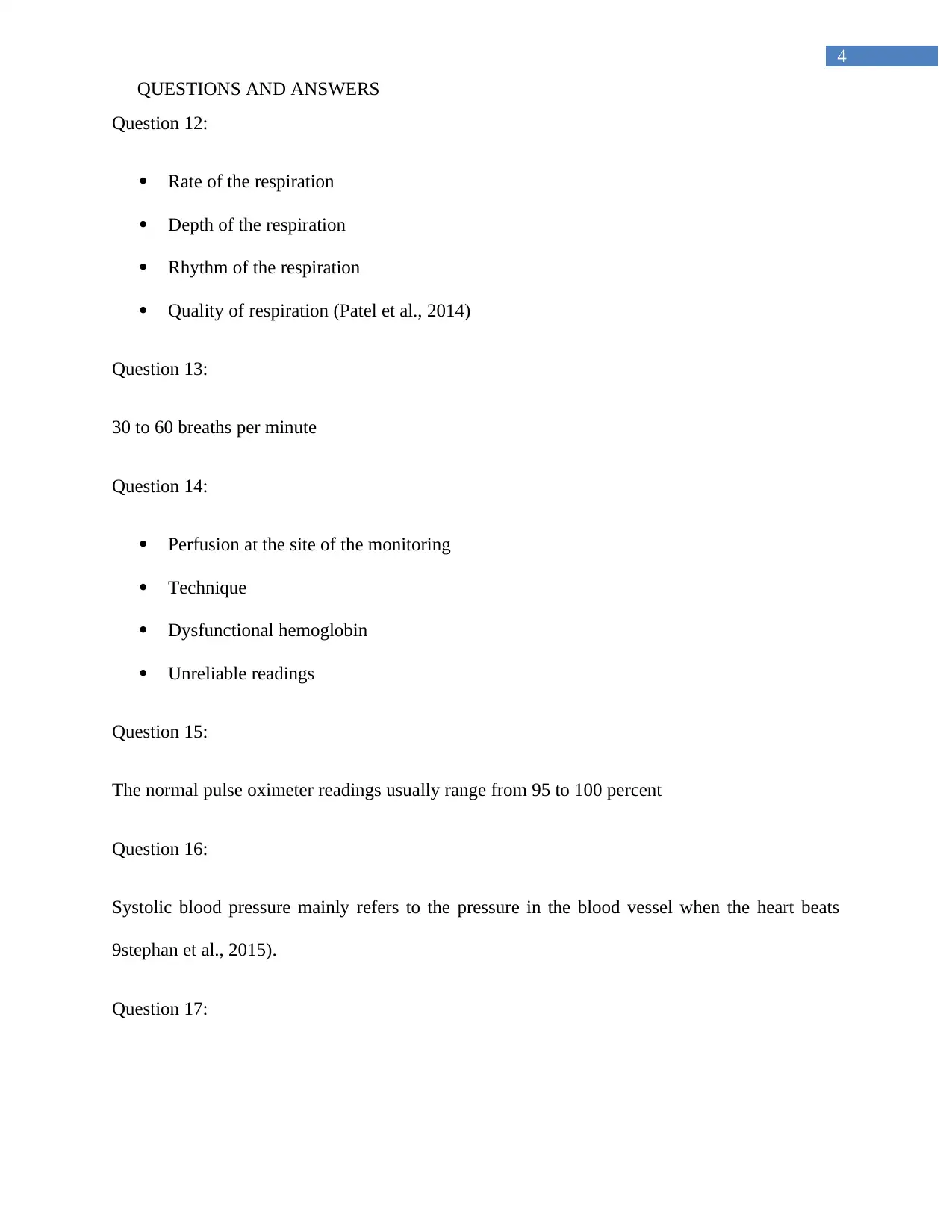
4
QUESTIONS AND ANSWERS
Question 12:
Rate of the respiration
Depth of the respiration
Rhythm of the respiration
Quality of respiration (Patel et al., 2014)
Question 13:
30 to 60 breaths per minute
Question 14:
Perfusion at the site of the monitoring
Technique
Dysfunctional hemoglobin
Unreliable readings
Question 15:
The normal pulse oximeter readings usually range from 95 to 100 percent
Question 16:
Systolic blood pressure mainly refers to the pressure in the blood vessel when the heart beats
9stephan et al., 2015).
Question 17:
QUESTIONS AND ANSWERS
Question 12:
Rate of the respiration
Depth of the respiration
Rhythm of the respiration
Quality of respiration (Patel et al., 2014)
Question 13:
30 to 60 breaths per minute
Question 14:
Perfusion at the site of the monitoring
Technique
Dysfunctional hemoglobin
Unreliable readings
Question 15:
The normal pulse oximeter readings usually range from 95 to 100 percent
Question 16:
Systolic blood pressure mainly refers to the pressure in the blood vessel when the heart beats
9stephan et al., 2015).
Question 17:
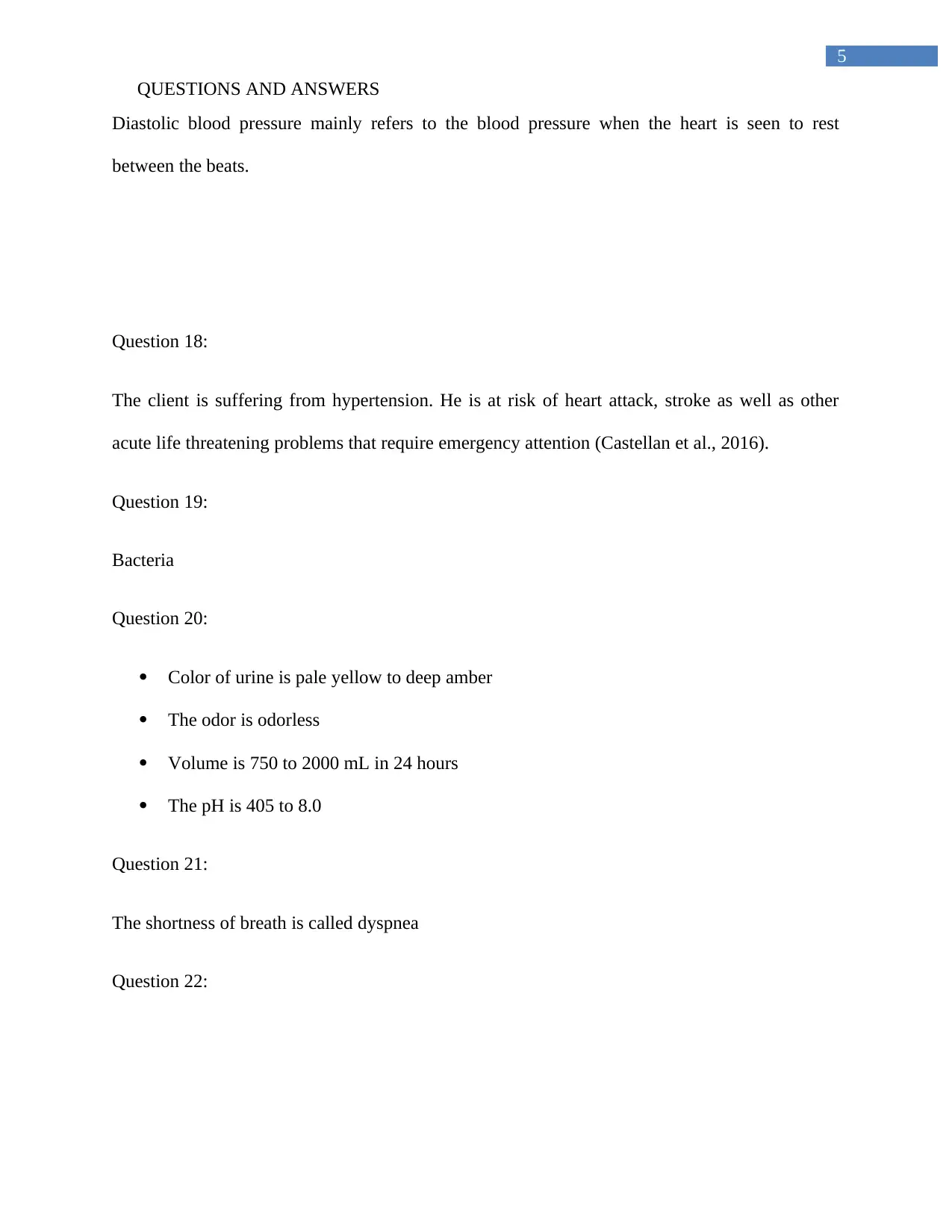
5
QUESTIONS AND ANSWERS
Diastolic blood pressure mainly refers to the blood pressure when the heart is seen to rest
between the beats.
Question 18:
The client is suffering from hypertension. He is at risk of heart attack, stroke as well as other
acute life threatening problems that require emergency attention (Castellan et al., 2016).
Question 19:
Bacteria
Question 20:
Color of urine is pale yellow to deep amber
The odor is odorless
Volume is 750 to 2000 mL in 24 hours
The pH is 405 to 8.0
Question 21:
The shortness of breath is called dyspnea
Question 22:
QUESTIONS AND ANSWERS
Diastolic blood pressure mainly refers to the blood pressure when the heart is seen to rest
between the beats.
Question 18:
The client is suffering from hypertension. He is at risk of heart attack, stroke as well as other
acute life threatening problems that require emergency attention (Castellan et al., 2016).
Question 19:
Bacteria
Question 20:
Color of urine is pale yellow to deep amber
The odor is odorless
Volume is 750 to 2000 mL in 24 hours
The pH is 405 to 8.0
Question 21:
The shortness of breath is called dyspnea
Question 22:
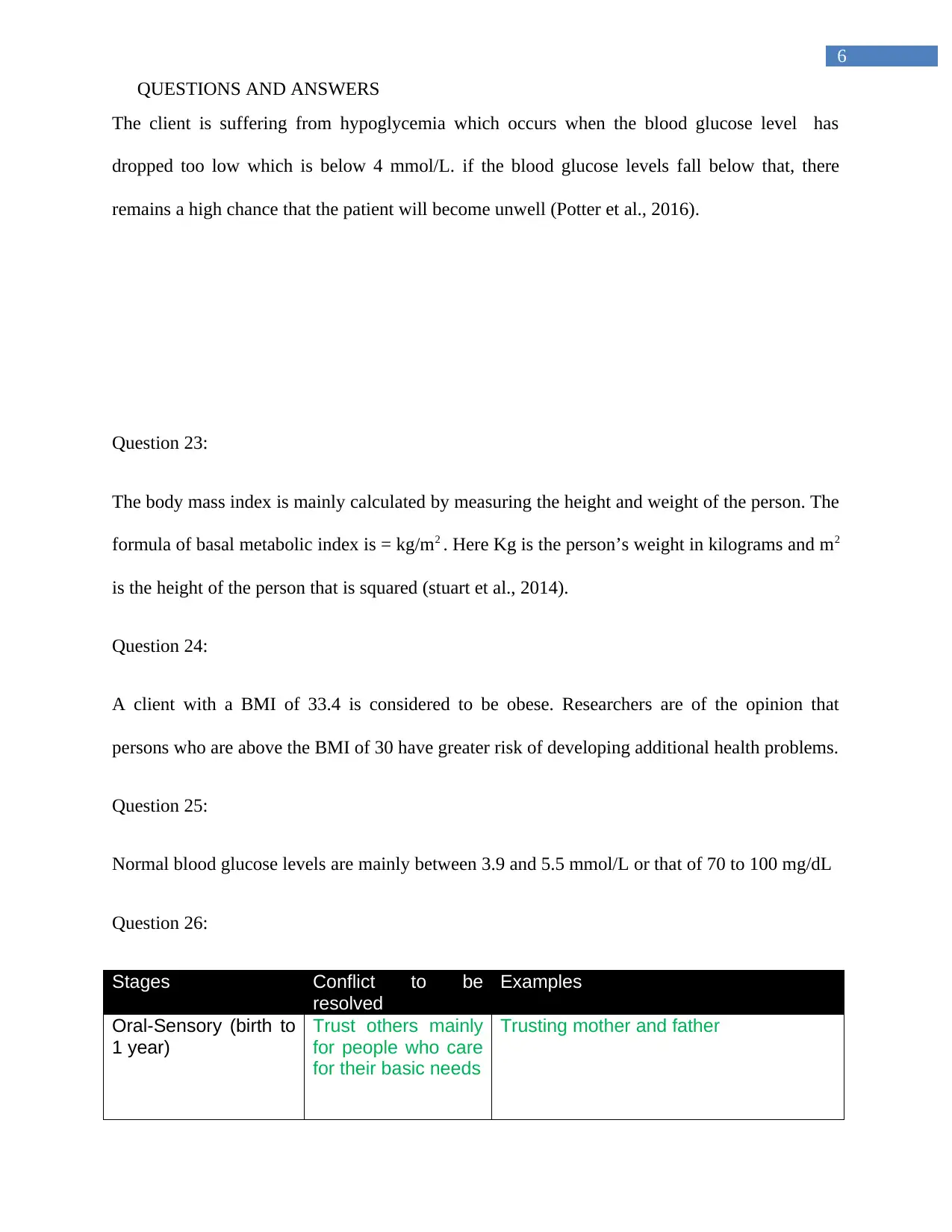
6
QUESTIONS AND ANSWERS
The client is suffering from hypoglycemia which occurs when the blood glucose level has
dropped too low which is below 4 mmol/L. if the blood glucose levels fall below that, there
remains a high chance that the patient will become unwell (Potter et al., 2016).
Question 23:
The body mass index is mainly calculated by measuring the height and weight of the person. The
formula of basal metabolic index is = kg/m2 . Here Kg is the person’s weight in kilograms and m2
is the height of the person that is squared (stuart et al., 2014).
Question 24:
A client with a BMI of 33.4 is considered to be obese. Researchers are of the opinion that
persons who are above the BMI of 30 have greater risk of developing additional health problems.
Question 25:
Normal blood glucose levels are mainly between 3.9 and 5.5 mmol/L or that of 70 to 100 mg/dL
Question 26:
Stages Conflict to be
resolved
Examples
Oral-Sensory (birth to
1 year)
Trust others mainly
for people who care
for their basic needs
Trusting mother and father
QUESTIONS AND ANSWERS
The client is suffering from hypoglycemia which occurs when the blood glucose level has
dropped too low which is below 4 mmol/L. if the blood glucose levels fall below that, there
remains a high chance that the patient will become unwell (Potter et al., 2016).
Question 23:
The body mass index is mainly calculated by measuring the height and weight of the person. The
formula of basal metabolic index is = kg/m2 . Here Kg is the person’s weight in kilograms and m2
is the height of the person that is squared (stuart et al., 2014).
Question 24:
A client with a BMI of 33.4 is considered to be obese. Researchers are of the opinion that
persons who are above the BMI of 30 have greater risk of developing additional health problems.
Question 25:
Normal blood glucose levels are mainly between 3.9 and 5.5 mmol/L or that of 70 to 100 mg/dL
Question 26:
Stages Conflict to be
resolved
Examples
Oral-Sensory (birth to
1 year)
Trust others mainly
for people who care
for their basic needs
Trusting mother and father
Paraphrase This Document
Need a fresh take? Get an instant paraphrase of this document with our AI Paraphraser
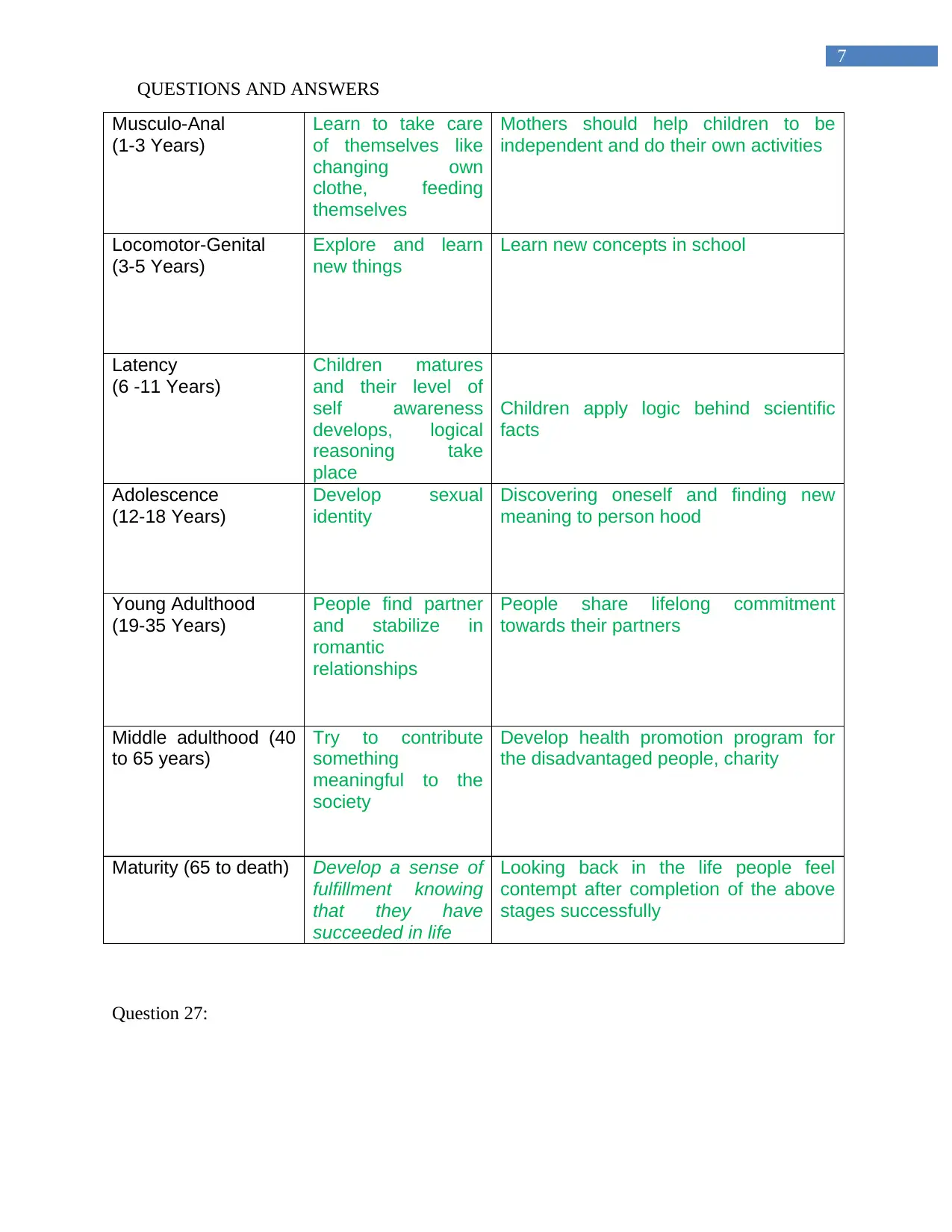
7
QUESTIONS AND ANSWERS
Musculo-Anal
(1-3 Years)
Learn to take care
of themselves like
changing own
clothe, feeding
themselves
Mothers should help children to be
independent and do their own activities
Locomotor-Genital
(3-5 Years)
Explore and learn
new things
Learn new concepts in school
Latency
(6 -11 Years)
Children matures
and their level of
self awareness
develops, logical
reasoning take
place
Children apply logic behind scientific
facts
Adolescence
(12-18 Years)
Develop sexual
identity
Discovering oneself and finding new
meaning to person hood
Young Adulthood
(19-35 Years)
People find partner
and stabilize in
romantic
relationships
People share lifelong commitment
towards their partners
Middle adulthood (40
to 65 years)
Try to contribute
something
meaningful to the
society
Develop health promotion program for
the disadvantaged people, charity
Maturity (65 to death) Develop a sense of
fulfillment knowing
that they have
succeeded in life
Looking back in the life people feel
contempt after completion of the above
stages successfully
Question 27:
QUESTIONS AND ANSWERS
Musculo-Anal
(1-3 Years)
Learn to take care
of themselves like
changing own
clothe, feeding
themselves
Mothers should help children to be
independent and do their own activities
Locomotor-Genital
(3-5 Years)
Explore and learn
new things
Learn new concepts in school
Latency
(6 -11 Years)
Children matures
and their level of
self awareness
develops, logical
reasoning take
place
Children apply logic behind scientific
facts
Adolescence
(12-18 Years)
Develop sexual
identity
Discovering oneself and finding new
meaning to person hood
Young Adulthood
(19-35 Years)
People find partner
and stabilize in
romantic
relationships
People share lifelong commitment
towards their partners
Middle adulthood (40
to 65 years)
Try to contribute
something
meaningful to the
society
Develop health promotion program for
the disadvantaged people, charity
Maturity (65 to death) Develop a sense of
fulfillment knowing
that they have
succeeded in life
Looking back in the life people feel
contempt after completion of the above
stages successfully
Question 27:

8
QUESTIONS AND ANSWERS
It is very important for the professionals to identify any unusual symptoms for clients
who have faced a head injury following a fall. Severe blow on the head may result in
swelling as well as damage to the brain. It is vitally important for the professionals to
recognize early as well as worrying signs of any types of increased pressure on the brain.
A clear indicator of more serious injury is when the person loses consciousness or shows
signs of confusion. Unconsciousness, abnormal breathing, disturbance of speech, vision,
weakness, dizziness, paralysis, bleeding or clear fluid from the nose and many others can
also provide cues of serious injuries (Feltnar et al., 2014). Citi scan and MRI should also
be done.
Electrocardiogram as well as chest radiographs mainly help in assessing the disorder.
These modalities are inexpensive, safe and can be easily accomplished
For assessing diabetes patient, blood glucose monitoring is important. HbA1C can be
taken. Home capillary glucose monitoring is also done.non fasting lipid profile should be
measured. Estimated glomerular filtration rate should be measured to check diabetic
nephropathy. Weight, abdominal circumference, height and BMi should be checked.
Urinalysis should also be done
Medical history should be taken. Possible investigations that should be involved are urine
dipstick, microscopy and culture analysis, pregnency test, test for sexually transmitted
disease, ultrasound of the urinary tract, plain kidney, ureters and bladder (KUB) X-ray to
find out renal tract stones, urine cytology, and others.
The professionals should first examine the portion that is within the cast before removing
the cast. The doctor will take an X ray of the cast along with the broken part inside it
QUESTIONS AND ANSWERS
It is very important for the professionals to identify any unusual symptoms for clients
who have faced a head injury following a fall. Severe blow on the head may result in
swelling as well as damage to the brain. It is vitally important for the professionals to
recognize early as well as worrying signs of any types of increased pressure on the brain.
A clear indicator of more serious injury is when the person loses consciousness or shows
signs of confusion. Unconsciousness, abnormal breathing, disturbance of speech, vision,
weakness, dizziness, paralysis, bleeding or clear fluid from the nose and many others can
also provide cues of serious injuries (Feltnar et al., 2014). Citi scan and MRI should also
be done.
Electrocardiogram as well as chest radiographs mainly help in assessing the disorder.
These modalities are inexpensive, safe and can be easily accomplished
For assessing diabetes patient, blood glucose monitoring is important. HbA1C can be
taken. Home capillary glucose monitoring is also done.non fasting lipid profile should be
measured. Estimated glomerular filtration rate should be measured to check diabetic
nephropathy. Weight, abdominal circumference, height and BMi should be checked.
Urinalysis should also be done
Medical history should be taken. Possible investigations that should be involved are urine
dipstick, microscopy and culture analysis, pregnency test, test for sexually transmitted
disease, ultrasound of the urinary tract, plain kidney, ureters and bladder (KUB) X-ray to
find out renal tract stones, urine cytology, and others.
The professionals should first examine the portion that is within the cast before removing
the cast. The doctor will take an X ray of the cast along with the broken part inside it
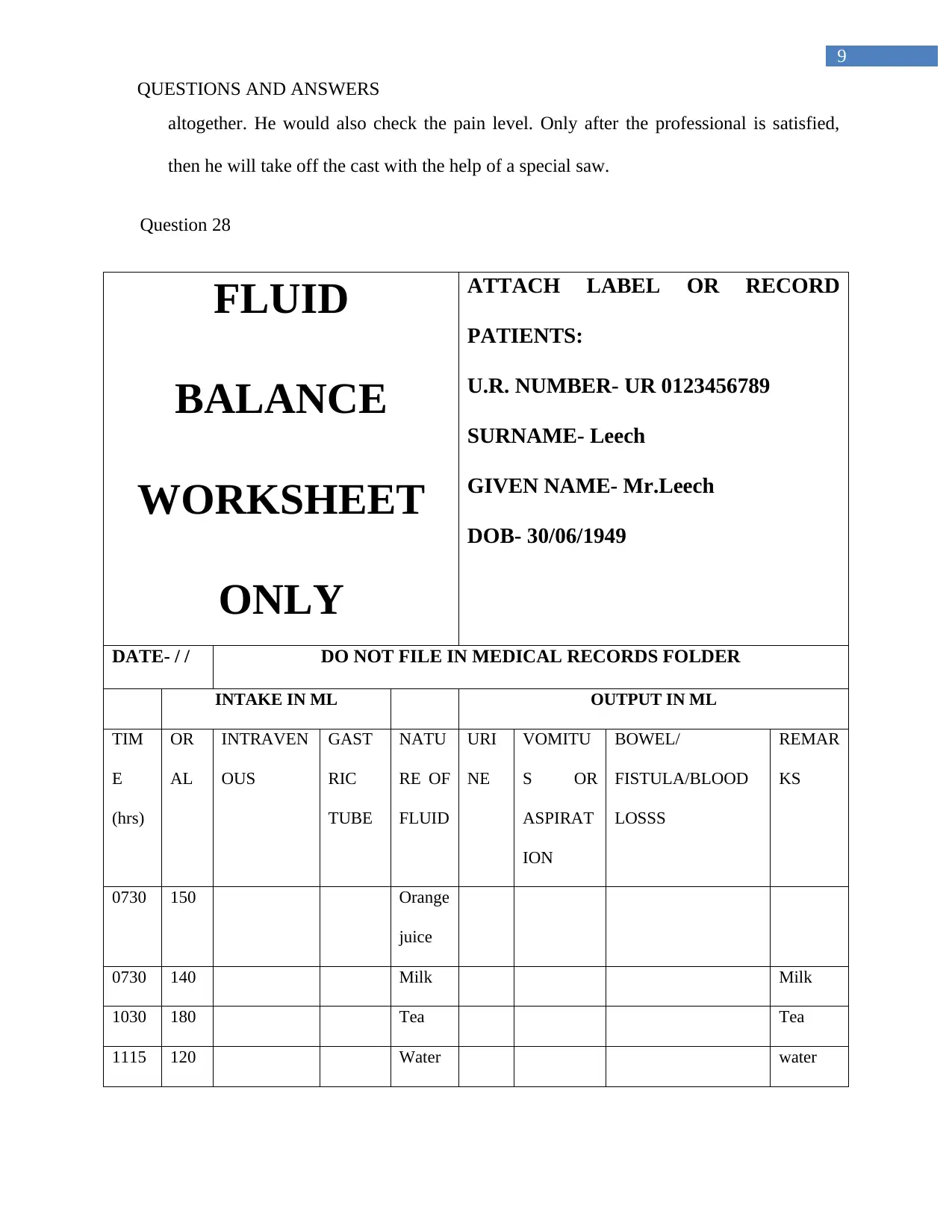
9
QUESTIONS AND ANSWERS
altogether. He would also check the pain level. Only after the professional is satisfied,
then he will take off the cast with the help of a special saw.
Question 28
FLUID
BALANCE
WORKSHEET
ONLY
ATTACH LABEL OR RECORD
PATIENTS:
U.R. NUMBER- UR 0123456789
SURNAME- Leech
GIVEN NAME- Mr.Leech
DOB- 30/06/1949
DATE- / / DO NOT FILE IN MEDICAL RECORDS FOLDER
INTAKE IN ML OUTPUT IN ML
TIM
E
(hrs)
OR
AL
INTRAVEN
OUS
GAST
RIC
TUBE
NATU
RE OF
FLUID
URI
NE
VOMITU
S OR
ASPIRAT
ION
BOWEL/
FISTULA/BLOOD
LOSSS
REMAR
KS
0730 150 Orange
juice
0730 140 Milk Milk
1030 180 Tea Tea
1115 120 Water water
QUESTIONS AND ANSWERS
altogether. He would also check the pain level. Only after the professional is satisfied,
then he will take off the cast with the help of a special saw.
Question 28
FLUID
BALANCE
WORKSHEET
ONLY
ATTACH LABEL OR RECORD
PATIENTS:
U.R. NUMBER- UR 0123456789
SURNAME- Leech
GIVEN NAME- Mr.Leech
DOB- 30/06/1949
DATE- / / DO NOT FILE IN MEDICAL RECORDS FOLDER
INTAKE IN ML OUTPUT IN ML
TIM
E
(hrs)
OR
AL
INTRAVEN
OUS
GAST
RIC
TUBE
NATU
RE OF
FLUID
URI
NE
VOMITU
S OR
ASPIRAT
ION
BOWEL/
FISTULA/BLOOD
LOSSS
REMAR
KS
0730 150 Orange
juice
0730 140 Milk Milk
1030 180 Tea Tea
1115 120 Water water
Secure Best Marks with AI Grader
Need help grading? Try our AI Grader for instant feedback on your assignments.
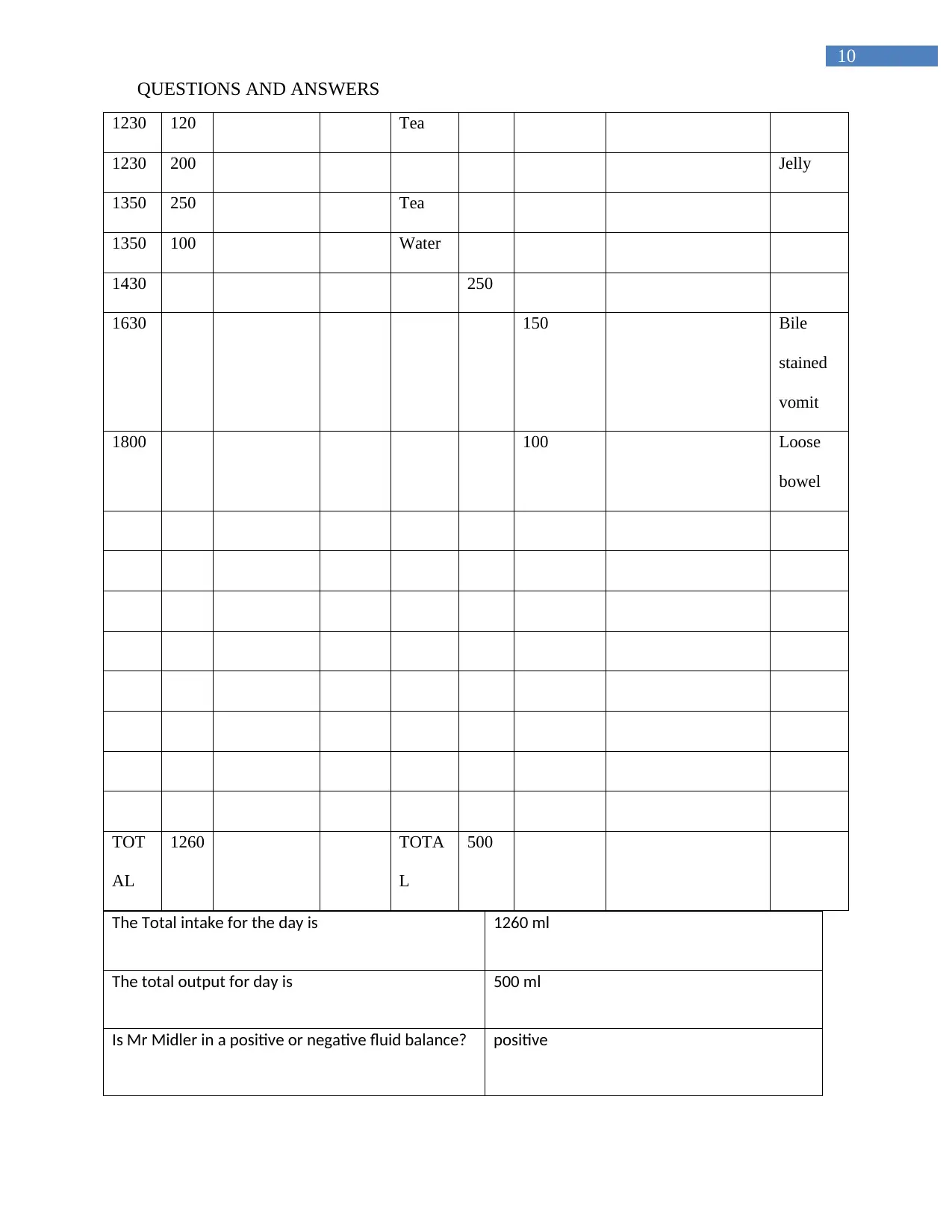
10
QUESTIONS AND ANSWERS
1230 120 Tea
1230 200 Jelly
1350 250 Tea
1350 100 Water
1430 250
1630 150 Bile
stained
vomit
1800 100 Loose
bowel
TOT
AL
1260 TOTA
L
500
The Total intake for the day is 1260 ml
The total output for day is 500 ml
Is Mr Midler in a positive or negative fluid balance? positive
QUESTIONS AND ANSWERS
1230 120 Tea
1230 200 Jelly
1350 250 Tea
1350 100 Water
1430 250
1630 150 Bile
stained
vomit
1800 100 Loose
bowel
TOT
AL
1260 TOTA
L
500
The Total intake for the day is 1260 ml
The total output for day is 500 ml
Is Mr Midler in a positive or negative fluid balance? positive
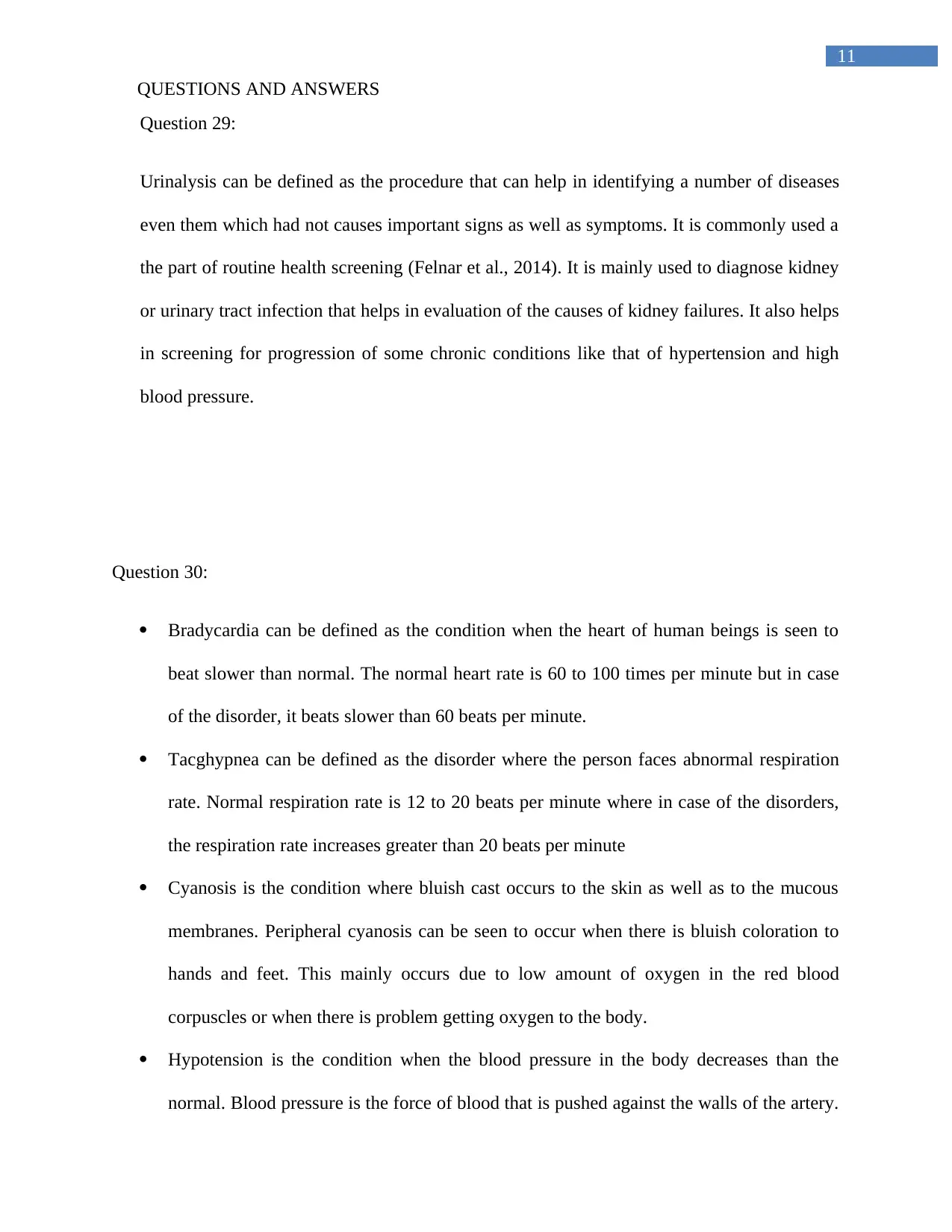
11
QUESTIONS AND ANSWERS
Question 29:
Urinalysis can be defined as the procedure that can help in identifying a number of diseases
even them which had not causes important signs as well as symptoms. It is commonly used a
the part of routine health screening (Felnar et al., 2014). It is mainly used to diagnose kidney
or urinary tract infection that helps in evaluation of the causes of kidney failures. It also helps
in screening for progression of some chronic conditions like that of hypertension and high
blood pressure.
Question 30:
Bradycardia can be defined as the condition when the heart of human beings is seen to
beat slower than normal. The normal heart rate is 60 to 100 times per minute but in case
of the disorder, it beats slower than 60 beats per minute.
Tacghypnea can be defined as the disorder where the person faces abnormal respiration
rate. Normal respiration rate is 12 to 20 beats per minute where in case of the disorders,
the respiration rate increases greater than 20 beats per minute
Cyanosis is the condition where bluish cast occurs to the skin as well as to the mucous
membranes. Peripheral cyanosis can be seen to occur when there is bluish coloration to
hands and feet. This mainly occurs due to low amount of oxygen in the red blood
corpuscles or when there is problem getting oxygen to the body.
Hypotension is the condition when the blood pressure in the body decreases than the
normal. Blood pressure is the force of blood that is pushed against the walls of the artery.
QUESTIONS AND ANSWERS
Question 29:
Urinalysis can be defined as the procedure that can help in identifying a number of diseases
even them which had not causes important signs as well as symptoms. It is commonly used a
the part of routine health screening (Felnar et al., 2014). It is mainly used to diagnose kidney
or urinary tract infection that helps in evaluation of the causes of kidney failures. It also helps
in screening for progression of some chronic conditions like that of hypertension and high
blood pressure.
Question 30:
Bradycardia can be defined as the condition when the heart of human beings is seen to
beat slower than normal. The normal heart rate is 60 to 100 times per minute but in case
of the disorder, it beats slower than 60 beats per minute.
Tacghypnea can be defined as the disorder where the person faces abnormal respiration
rate. Normal respiration rate is 12 to 20 beats per minute where in case of the disorders,
the respiration rate increases greater than 20 beats per minute
Cyanosis is the condition where bluish cast occurs to the skin as well as to the mucous
membranes. Peripheral cyanosis can be seen to occur when there is bluish coloration to
hands and feet. This mainly occurs due to low amount of oxygen in the red blood
corpuscles or when there is problem getting oxygen to the body.
Hypotension is the condition when the blood pressure in the body decreases than the
normal. Blood pressure is the force of blood that is pushed against the walls of the artery.
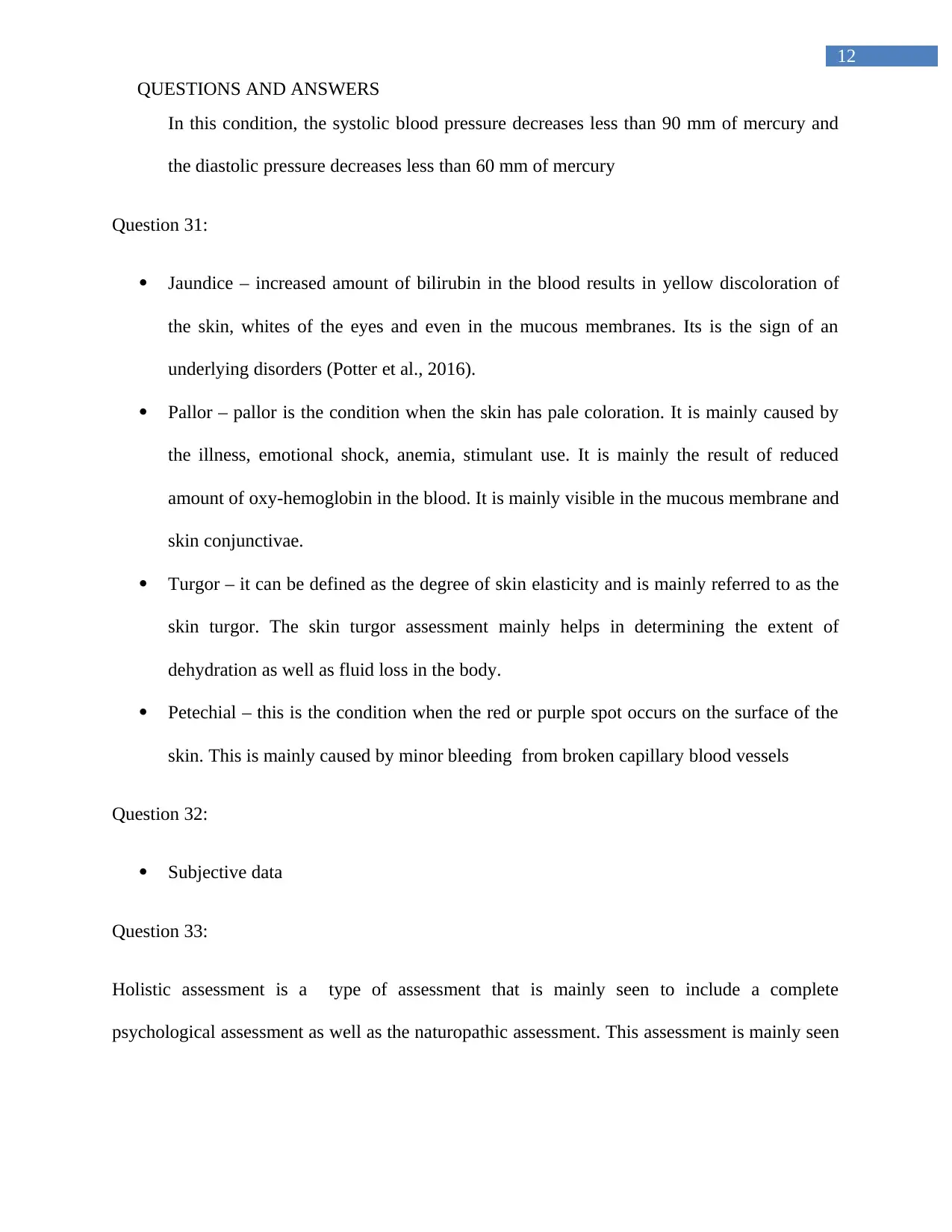
12
QUESTIONS AND ANSWERS
In this condition, the systolic blood pressure decreases less than 90 mm of mercury and
the diastolic pressure decreases less than 60 mm of mercury
Question 31:
Jaundice – increased amount of bilirubin in the blood results in yellow discoloration of
the skin, whites of the eyes and even in the mucous membranes. Its is the sign of an
underlying disorders (Potter et al., 2016).
Pallor – pallor is the condition when the skin has pale coloration. It is mainly caused by
the illness, emotional shock, anemia, stimulant use. It is mainly the result of reduced
amount of oxy-hemoglobin in the blood. It is mainly visible in the mucous membrane and
skin conjunctivae.
Turgor – it can be defined as the degree of skin elasticity and is mainly referred to as the
skin turgor. The skin turgor assessment mainly helps in determining the extent of
dehydration as well as fluid loss in the body.
Petechial – this is the condition when the red or purple spot occurs on the surface of the
skin. This is mainly caused by minor bleeding from broken capillary blood vessels
Question 32:
Subjective data
Question 33:
Holistic assessment is a type of assessment that is mainly seen to include a complete
psychological assessment as well as the naturopathic assessment. This assessment is mainly seen
QUESTIONS AND ANSWERS
In this condition, the systolic blood pressure decreases less than 90 mm of mercury and
the diastolic pressure decreases less than 60 mm of mercury
Question 31:
Jaundice – increased amount of bilirubin in the blood results in yellow discoloration of
the skin, whites of the eyes and even in the mucous membranes. Its is the sign of an
underlying disorders (Potter et al., 2016).
Pallor – pallor is the condition when the skin has pale coloration. It is mainly caused by
the illness, emotional shock, anemia, stimulant use. It is mainly the result of reduced
amount of oxy-hemoglobin in the blood. It is mainly visible in the mucous membrane and
skin conjunctivae.
Turgor – it can be defined as the degree of skin elasticity and is mainly referred to as the
skin turgor. The skin turgor assessment mainly helps in determining the extent of
dehydration as well as fluid loss in the body.
Petechial – this is the condition when the red or purple spot occurs on the surface of the
skin. This is mainly caused by minor bleeding from broken capillary blood vessels
Question 32:
Subjective data
Question 33:
Holistic assessment is a type of assessment that is mainly seen to include a complete
psychological assessment as well as the naturopathic assessment. This assessment is mainly seen
Paraphrase This Document
Need a fresh take? Get an instant paraphrase of this document with our AI Paraphraser

13
QUESTIONS AND ANSWERS
to cover emotional, biochemical, psychological, historical, social as well as spiritual causes of
the mental health issues.
Question 34:
There are three important components that are the eye which has 4 important scales to be
diagnosed. There is the verbal response that has five important grades that include no verbal
response, incomprehensive sounds, and inappropriate words, confused as well as oriented (stuart
et al., 2014). Then there is the motor response that has 6 grades like no response, decorticate
posturing, decorticate posturing, withdrawal of pain, localization to pain and obeying commands
Question 35:
Part A:
The child should be assessed to find out whether the child falls in the category of “No clinically
detectable dehydration” where the nurse should find out consciousness of the child, thirst, urine
output, skin color, warmth of hands and feet. The next category is the “clinical dehydration”
where the nurses need to find out the child is irritable or lathergic, increased thirst, decreased
urine output, skin color and warmth of hands and feet. The third category is the clinical shock
where the nurse need to find out whether the child is in depressed conscious state, pale of
mottled skin, cold hands and feet.
Part b:
The nurse should immediately ask the parents or the guardian about the medication that the child
is allergic to. Moreover, she would also need to find out that the stat dose medication are causing
QUESTIONS AND ANSWERS
to cover emotional, biochemical, psychological, historical, social as well as spiritual causes of
the mental health issues.
Question 34:
There are three important components that are the eye which has 4 important scales to be
diagnosed. There is the verbal response that has five important grades that include no verbal
response, incomprehensive sounds, and inappropriate words, confused as well as oriented (stuart
et al., 2014). Then there is the motor response that has 6 grades like no response, decorticate
posturing, decorticate posturing, withdrawal of pain, localization to pain and obeying commands
Question 35:
Part A:
The child should be assessed to find out whether the child falls in the category of “No clinically
detectable dehydration” where the nurse should find out consciousness of the child, thirst, urine
output, skin color, warmth of hands and feet. The next category is the “clinical dehydration”
where the nurses need to find out the child is irritable or lathergic, increased thirst, decreased
urine output, skin color and warmth of hands and feet. The third category is the clinical shock
where the nurse need to find out whether the child is in depressed conscious state, pale of
mottled skin, cold hands and feet.
Part b:
The nurse should immediately ask the parents or the guardian about the medication that the child
is allergic to. Moreover, she would also need to find out that the stat dose medication are causing
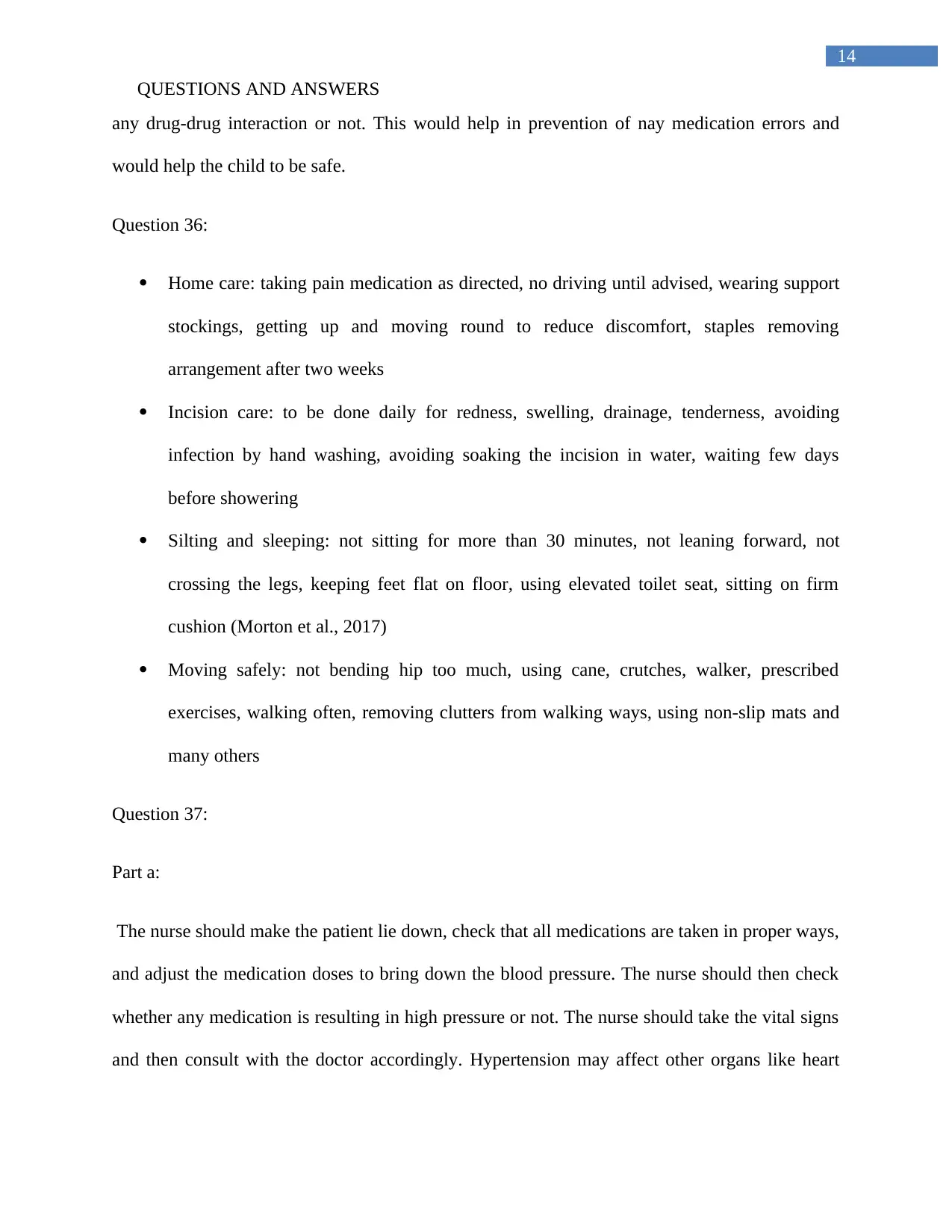
14
QUESTIONS AND ANSWERS
any drug-drug interaction or not. This would help in prevention of nay medication errors and
would help the child to be safe.
Question 36:
Home care: taking pain medication as directed, no driving until advised, wearing support
stockings, getting up and moving round to reduce discomfort, staples removing
arrangement after two weeks
Incision care: to be done daily for redness, swelling, drainage, tenderness, avoiding
infection by hand washing, avoiding soaking the incision in water, waiting few days
before showering
Silting and sleeping: not sitting for more than 30 minutes, not leaning forward, not
crossing the legs, keeping feet flat on floor, using elevated toilet seat, sitting on firm
cushion (Morton et al., 2017)
Moving safely: not bending hip too much, using cane, crutches, walker, prescribed
exercises, walking often, removing clutters from walking ways, using non-slip mats and
many others
Question 37:
Part a:
The nurse should make the patient lie down, check that all medications are taken in proper ways,
and adjust the medication doses to bring down the blood pressure. The nurse should then check
whether any medication is resulting in high pressure or not. The nurse should take the vital signs
and then consult with the doctor accordingly. Hypertension may affect other organs like heart
QUESTIONS AND ANSWERS
any drug-drug interaction or not. This would help in prevention of nay medication errors and
would help the child to be safe.
Question 36:
Home care: taking pain medication as directed, no driving until advised, wearing support
stockings, getting up and moving round to reduce discomfort, staples removing
arrangement after two weeks
Incision care: to be done daily for redness, swelling, drainage, tenderness, avoiding
infection by hand washing, avoiding soaking the incision in water, waiting few days
before showering
Silting and sleeping: not sitting for more than 30 minutes, not leaning forward, not
crossing the legs, keeping feet flat on floor, using elevated toilet seat, sitting on firm
cushion (Morton et al., 2017)
Moving safely: not bending hip too much, using cane, crutches, walker, prescribed
exercises, walking often, removing clutters from walking ways, using non-slip mats and
many others
Question 37:
Part a:
The nurse should make the patient lie down, check that all medications are taken in proper ways,
and adjust the medication doses to bring down the blood pressure. The nurse should then check
whether any medication is resulting in high pressure or not. The nurse should take the vital signs
and then consult with the doctor accordingly. Hypertension may affect other organs like heart
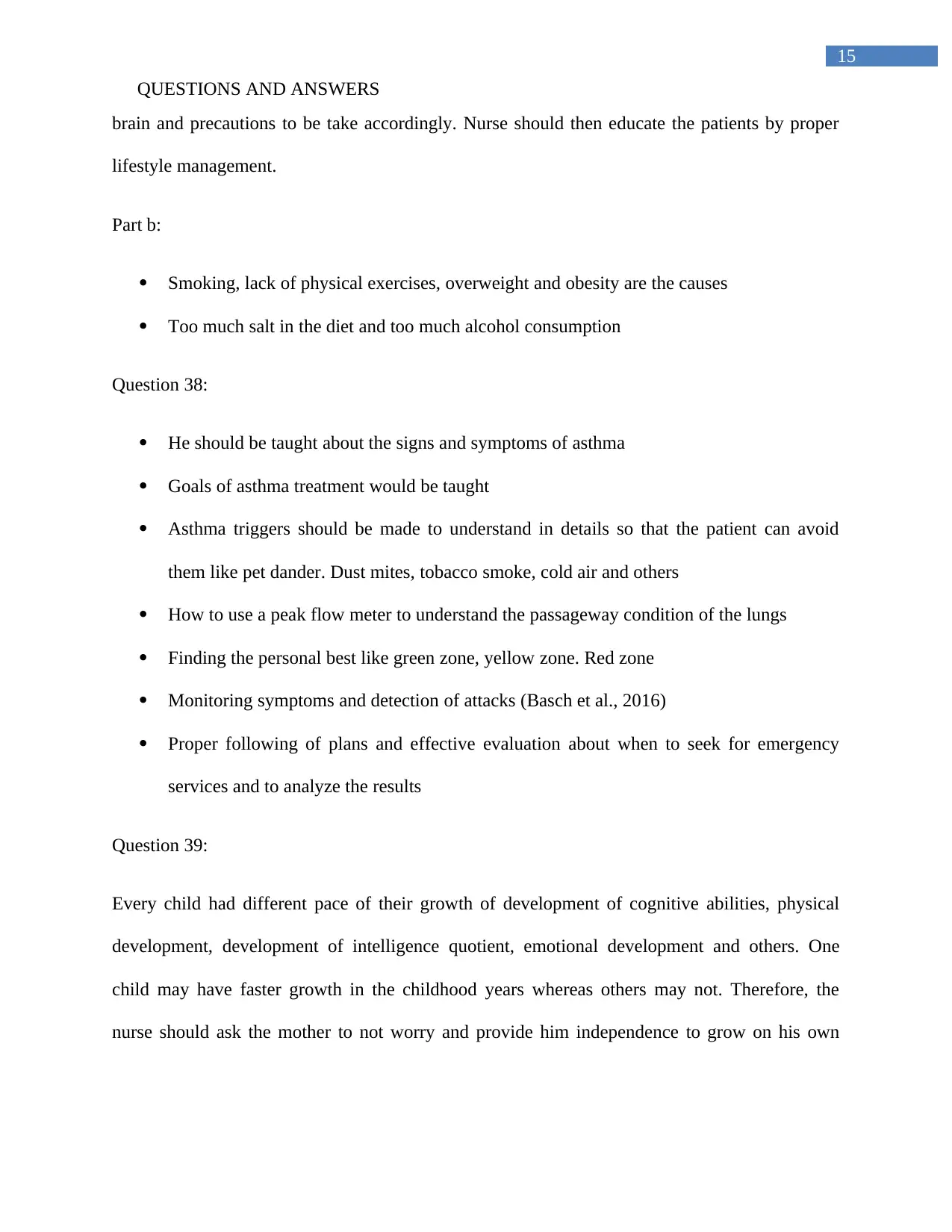
15
QUESTIONS AND ANSWERS
brain and precautions to be take accordingly. Nurse should then educate the patients by proper
lifestyle management.
Part b:
Smoking, lack of physical exercises, overweight and obesity are the causes
Too much salt in the diet and too much alcohol consumption
Question 38:
He should be taught about the signs and symptoms of asthma
Goals of asthma treatment would be taught
Asthma triggers should be made to understand in details so that the patient can avoid
them like pet dander. Dust mites, tobacco smoke, cold air and others
How to use a peak flow meter to understand the passageway condition of the lungs
Finding the personal best like green zone, yellow zone. Red zone
Monitoring symptoms and detection of attacks (Basch et al., 2016)
Proper following of plans and effective evaluation about when to seek for emergency
services and to analyze the results
Question 39:
Every child had different pace of their growth of development of cognitive abilities, physical
development, development of intelligence quotient, emotional development and others. One
child may have faster growth in the childhood years whereas others may not. Therefore, the
nurse should ask the mother to not worry and provide him independence to grow on his own
QUESTIONS AND ANSWERS
brain and precautions to be take accordingly. Nurse should then educate the patients by proper
lifestyle management.
Part b:
Smoking, lack of physical exercises, overweight and obesity are the causes
Too much salt in the diet and too much alcohol consumption
Question 38:
He should be taught about the signs and symptoms of asthma
Goals of asthma treatment would be taught
Asthma triggers should be made to understand in details so that the patient can avoid
them like pet dander. Dust mites, tobacco smoke, cold air and others
How to use a peak flow meter to understand the passageway condition of the lungs
Finding the personal best like green zone, yellow zone. Red zone
Monitoring symptoms and detection of attacks (Basch et al., 2016)
Proper following of plans and effective evaluation about when to seek for emergency
services and to analyze the results
Question 39:
Every child had different pace of their growth of development of cognitive abilities, physical
development, development of intelligence quotient, emotional development and others. One
child may have faster growth in the childhood years whereas others may not. Therefore, the
nurse should ask the mother to not worry and provide him independence to grow on his own
Secure Best Marks with AI Grader
Need help grading? Try our AI Grader for instant feedback on your assignments.

16
QUESTIONS AND ANSWERS
pace so that he can enjoy the time and does not feel pressurized. Pressurizing might have
negative effect on his brain development and emotional attachments.
Question 40:
QUESTIONS AND ANSWERS
pace so that he can enjoy the time and does not feel pressurized. Pressurizing might have
negative effect on his brain development and emotional attachments.
Question 40:
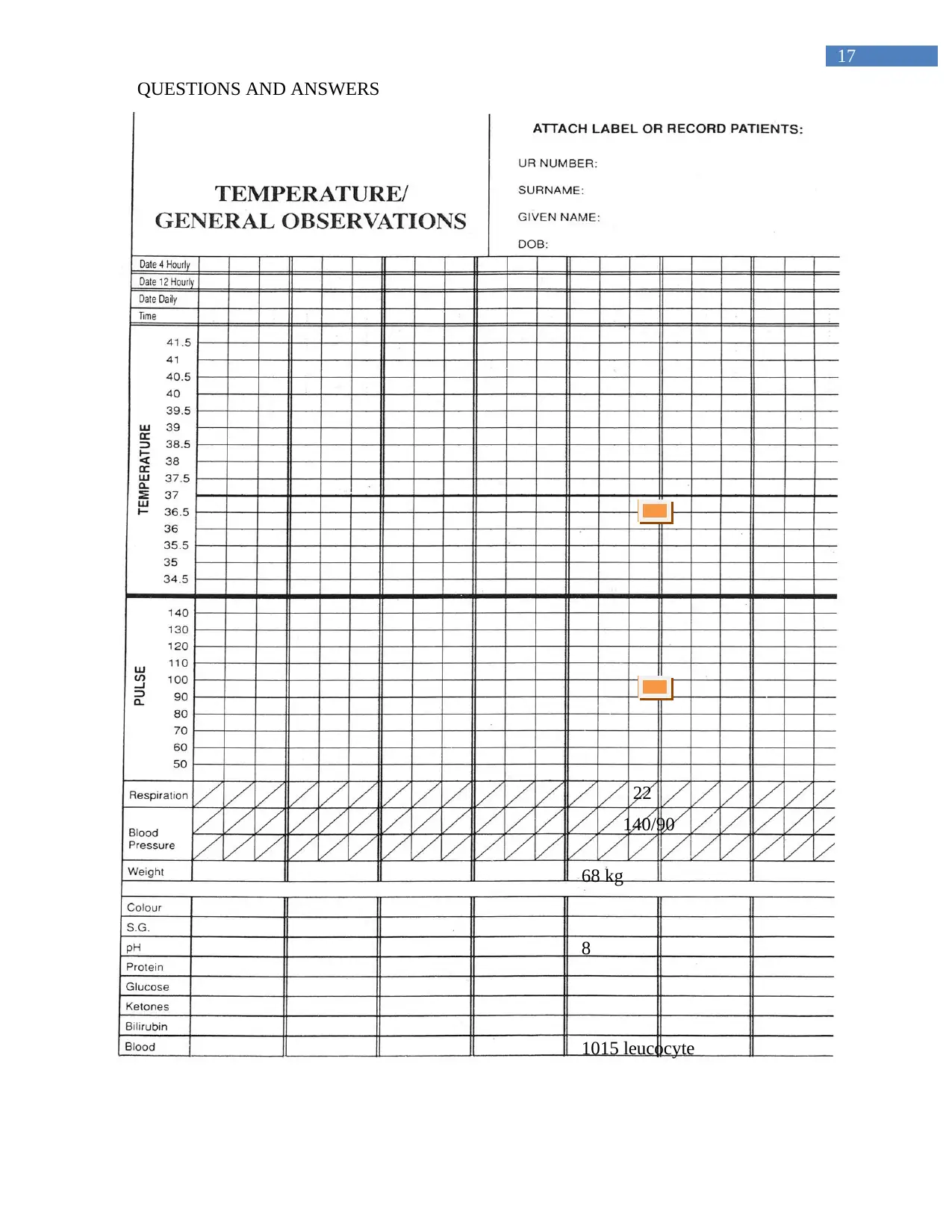
17
QUESTIONS AND ANSWERS
22
140/90
68 kg
8
1015 leucocyte
QUESTIONS AND ANSWERS
22
140/90
68 kg
8
1015 leucocyte
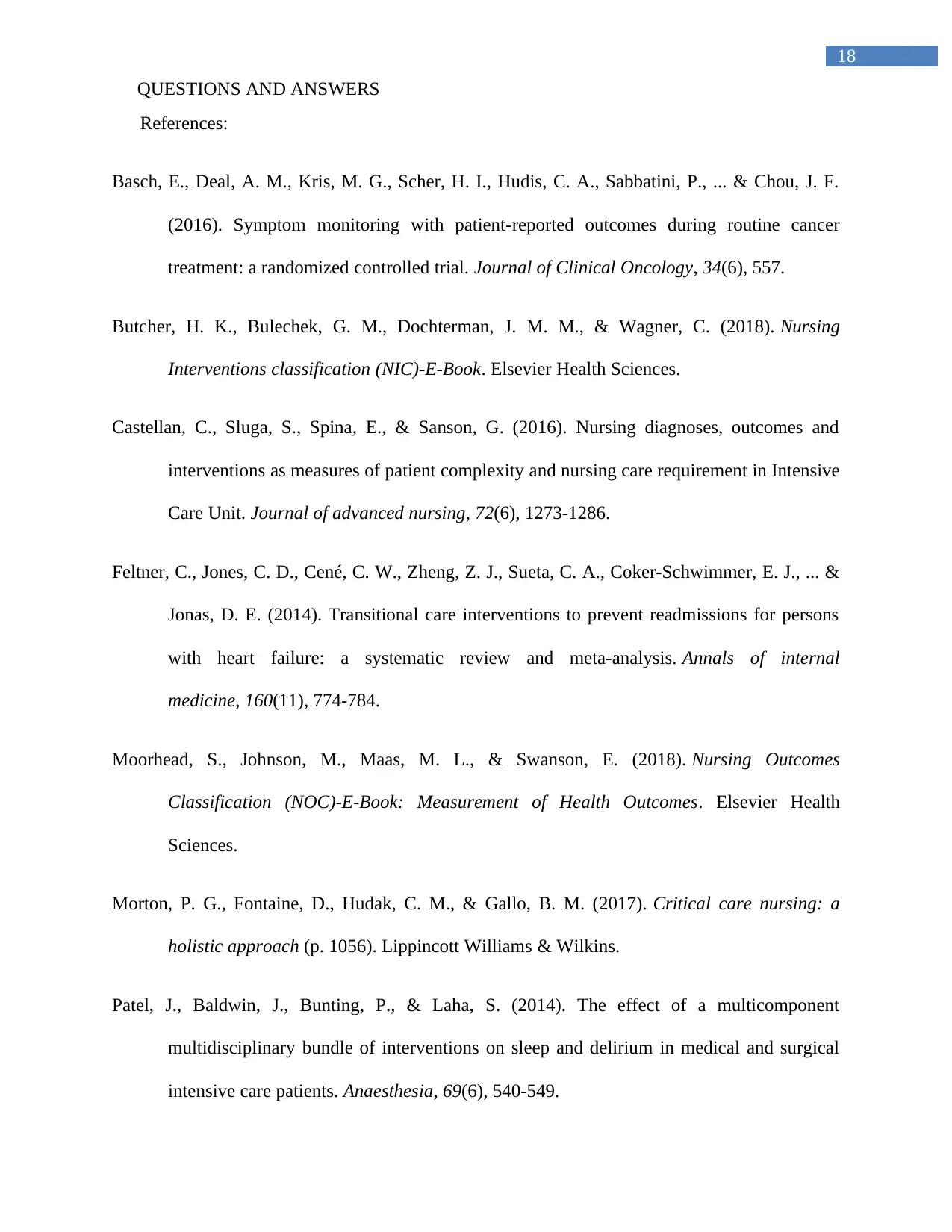
18
QUESTIONS AND ANSWERS
References:
Basch, E., Deal, A. M., Kris, M. G., Scher, H. I., Hudis, C. A., Sabbatini, P., ... & Chou, J. F.
(2016). Symptom monitoring with patient-reported outcomes during routine cancer
treatment: a randomized controlled trial. Journal of Clinical Oncology, 34(6), 557.
Butcher, H. K., Bulechek, G. M., Dochterman, J. M. M., & Wagner, C. (2018). Nursing
Interventions classification (NIC)-E-Book. Elsevier Health Sciences.
Castellan, C., Sluga, S., Spina, E., & Sanson, G. (2016). Nursing diagnoses, outcomes and
interventions as measures of patient complexity and nursing care requirement in Intensive
Care Unit. Journal of advanced nursing, 72(6), 1273-1286.
Feltner, C., Jones, C. D., Cené, C. W., Zheng, Z. J., Sueta, C. A., Coker-Schwimmer, E. J., ... &
Jonas, D. E. (2014). Transitional care interventions to prevent readmissions for persons
with heart failure: a systematic review and meta-analysis. Annals of internal
medicine, 160(11), 774-784.
Moorhead, S., Johnson, M., Maas, M. L., & Swanson, E. (2018). Nursing Outcomes
Classification (NOC)-E-Book: Measurement of Health Outcomes. Elsevier Health
Sciences.
Morton, P. G., Fontaine, D., Hudak, C. M., & Gallo, B. M. (2017). Critical care nursing: a
holistic approach (p. 1056). Lippincott Williams & Wilkins.
Patel, J., Baldwin, J., Bunting, P., & Laha, S. (2014). The effect of a multicomponent
multidisciplinary bundle of interventions on sleep and delirium in medical and surgical
intensive care patients. Anaesthesia, 69(6), 540-549.
QUESTIONS AND ANSWERS
References:
Basch, E., Deal, A. M., Kris, M. G., Scher, H. I., Hudis, C. A., Sabbatini, P., ... & Chou, J. F.
(2016). Symptom monitoring with patient-reported outcomes during routine cancer
treatment: a randomized controlled trial. Journal of Clinical Oncology, 34(6), 557.
Butcher, H. K., Bulechek, G. M., Dochterman, J. M. M., & Wagner, C. (2018). Nursing
Interventions classification (NIC)-E-Book. Elsevier Health Sciences.
Castellan, C., Sluga, S., Spina, E., & Sanson, G. (2016). Nursing diagnoses, outcomes and
interventions as measures of patient complexity and nursing care requirement in Intensive
Care Unit. Journal of advanced nursing, 72(6), 1273-1286.
Feltner, C., Jones, C. D., Cené, C. W., Zheng, Z. J., Sueta, C. A., Coker-Schwimmer, E. J., ... &
Jonas, D. E. (2014). Transitional care interventions to prevent readmissions for persons
with heart failure: a systematic review and meta-analysis. Annals of internal
medicine, 160(11), 774-784.
Moorhead, S., Johnson, M., Maas, M. L., & Swanson, E. (2018). Nursing Outcomes
Classification (NOC)-E-Book: Measurement of Health Outcomes. Elsevier Health
Sciences.
Morton, P. G., Fontaine, D., Hudak, C. M., & Gallo, B. M. (2017). Critical care nursing: a
holistic approach (p. 1056). Lippincott Williams & Wilkins.
Patel, J., Baldwin, J., Bunting, P., & Laha, S. (2014). The effect of a multicomponent
multidisciplinary bundle of interventions on sleep and delirium in medical and surgical
intensive care patients. Anaesthesia, 69(6), 540-549.
Paraphrase This Document
Need a fresh take? Get an instant paraphrase of this document with our AI Paraphraser
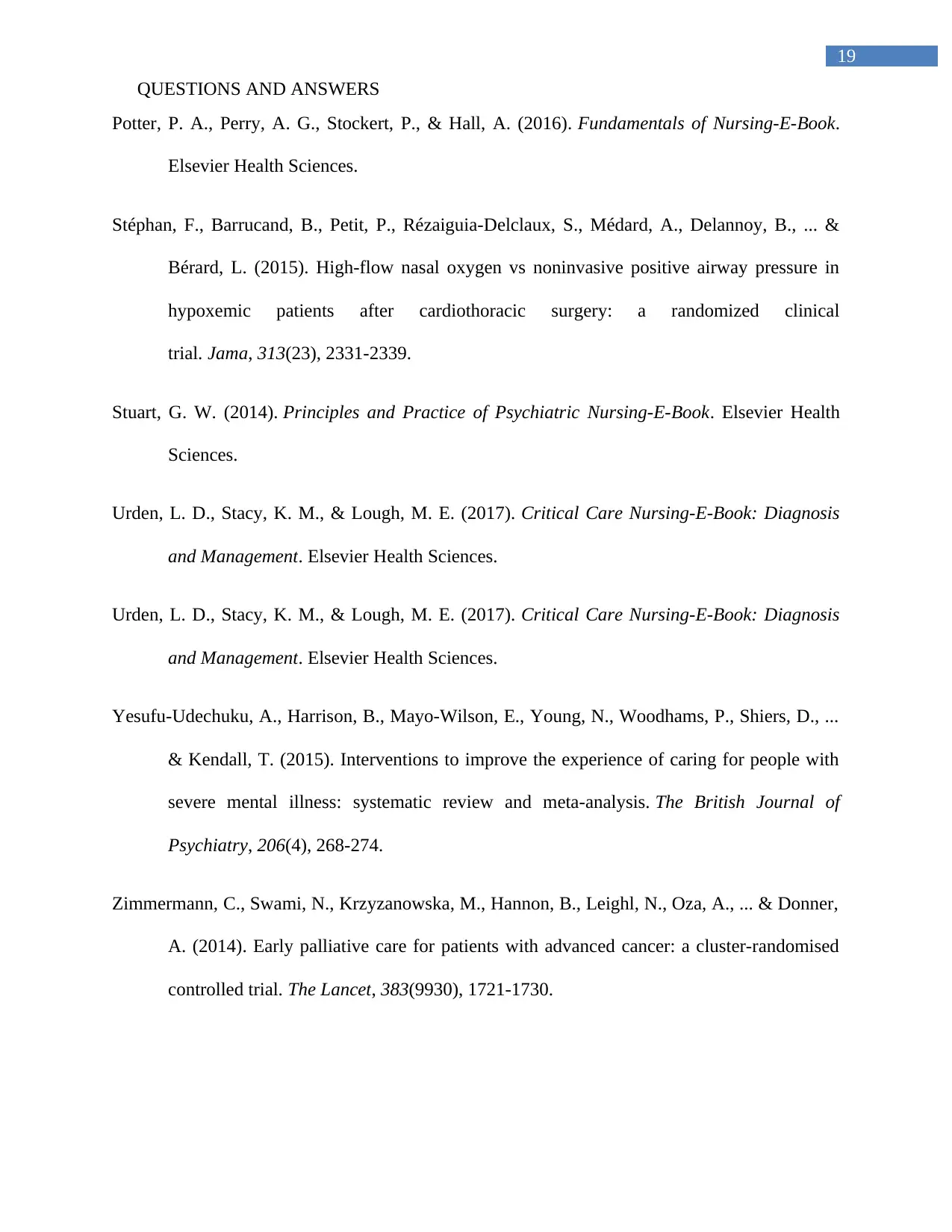
19
QUESTIONS AND ANSWERS
Potter, P. A., Perry, A. G., Stockert, P., & Hall, A. (2016). Fundamentals of Nursing-E-Book.
Elsevier Health Sciences.
Stéphan, F., Barrucand, B., Petit, P., Rézaiguia-Delclaux, S., Médard, A., Delannoy, B., ... &
Bérard, L. (2015). High-flow nasal oxygen vs noninvasive positive airway pressure in
hypoxemic patients after cardiothoracic surgery: a randomized clinical
trial. Jama, 313(23), 2331-2339.
Stuart, G. W. (2014). Principles and Practice of Psychiatric Nursing-E-Book. Elsevier Health
Sciences.
Urden, L. D., Stacy, K. M., & Lough, M. E. (2017). Critical Care Nursing-E-Book: Diagnosis
and Management. Elsevier Health Sciences.
Urden, L. D., Stacy, K. M., & Lough, M. E. (2017). Critical Care Nursing-E-Book: Diagnosis
and Management. Elsevier Health Sciences.
Yesufu-Udechuku, A., Harrison, B., Mayo-Wilson, E., Young, N., Woodhams, P., Shiers, D., ...
& Kendall, T. (2015). Interventions to improve the experience of caring for people with
severe mental illness: systematic review and meta-analysis. The British Journal of
Psychiatry, 206(4), 268-274.
Zimmermann, C., Swami, N., Krzyzanowska, M., Hannon, B., Leighl, N., Oza, A., ... & Donner,
A. (2014). Early palliative care for patients with advanced cancer: a cluster-randomised
controlled trial. The Lancet, 383(9930), 1721-1730.
QUESTIONS AND ANSWERS
Potter, P. A., Perry, A. G., Stockert, P., & Hall, A. (2016). Fundamentals of Nursing-E-Book.
Elsevier Health Sciences.
Stéphan, F., Barrucand, B., Petit, P., Rézaiguia-Delclaux, S., Médard, A., Delannoy, B., ... &
Bérard, L. (2015). High-flow nasal oxygen vs noninvasive positive airway pressure in
hypoxemic patients after cardiothoracic surgery: a randomized clinical
trial. Jama, 313(23), 2331-2339.
Stuart, G. W. (2014). Principles and Practice of Psychiatric Nursing-E-Book. Elsevier Health
Sciences.
Urden, L. D., Stacy, K. M., & Lough, M. E. (2017). Critical Care Nursing-E-Book: Diagnosis
and Management. Elsevier Health Sciences.
Urden, L. D., Stacy, K. M., & Lough, M. E. (2017). Critical Care Nursing-E-Book: Diagnosis
and Management. Elsevier Health Sciences.
Yesufu-Udechuku, A., Harrison, B., Mayo-Wilson, E., Young, N., Woodhams, P., Shiers, D., ...
& Kendall, T. (2015). Interventions to improve the experience of caring for people with
severe mental illness: systematic review and meta-analysis. The British Journal of
Psychiatry, 206(4), 268-274.
Zimmermann, C., Swami, N., Krzyzanowska, M., Hannon, B., Leighl, N., Oza, A., ... & Donner,
A. (2014). Early palliative care for patients with advanced cancer: a cluster-randomised
controlled trial. The Lancet, 383(9930), 1721-1730.
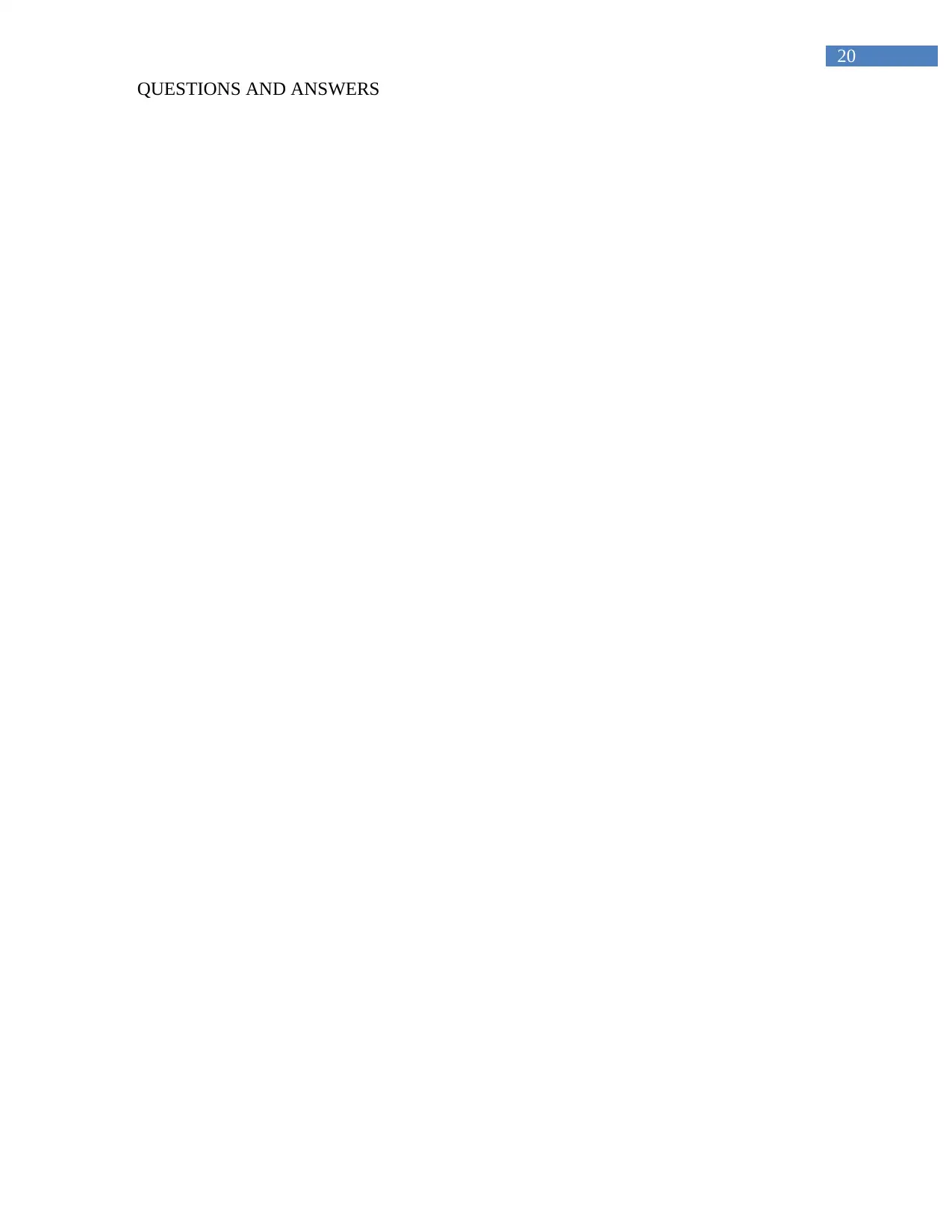
20
QUESTIONS AND ANSWERS
QUESTIONS AND ANSWERS
1 out of 21
Related Documents
Your All-in-One AI-Powered Toolkit for Academic Success.
+13062052269
info@desklib.com
Available 24*7 on WhatsApp / Email
![[object Object]](/_next/static/media/star-bottom.7253800d.svg)
Unlock your academic potential
© 2024 | Zucol Services PVT LTD | All rights reserved.





